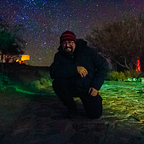4 Southern Constellations You Need to Know
The night sky is inspiring. Even with all of our advanced instruments and telescopes, it’s impossible not gaze the sky with just naked eyes and start asking questions about life — outside downtown, surely.
There are 88 officially constellations recognized by the IAU (International Astronomical Union). Here in this article, I want to show you interesting facts and how to find four lovely constellations from the South.
1 — Scorpius
Scorpius contains many bright stars, but I do like Antares. The rival of Mars! A war to know who is redder, by the way. It is the most shining star in the Scorpius constellation and the 16th brightest star in the night sky.
For me, the easiest way to identify this constellation is by finding Antares first. Once you distinguish it, start drawing its curving tail. It isn’t that difficult because the constellation is located near the center of the Milky Way. Scorpius represents 1.2% of the sky, and it has a fabulous star so-called U Scorpii, which is a recurrent nova system.
A nova is a nuclear explosion in a white dwarf star that occurs as a result of hydrogen accretion on the star’s surface by pulling gas from a fellow star. The interesting fact is that U Scorpii has the largest number of recorded outbursts! We’ve been observing in 1863, 1906, 1917, 1936, 1945, 1969, 1979, 1987, 1999, and 2010.
2 — Canis Major
By greek mythology, Canis Major is Laelaps incrassatus, a mighty female dog that never failed to catch his prey — or anything. It has this elegant star, Sirius. The combination of its size, luminosity, and proximity to the Solar System makes this star the brightest one in the night sky. It is known that in Egypt, Sirius was vital. The Star of Isis! About 5,000 years ago, the Egyptians figured out that when Sirius was rising just before the Sun, it would soon be time for the Nile River flooding. Not in a direct correlation but as a time marker.
Precisely, Sirius is a binary system. Its companion, Sirius B, is a white dwarf star, about 10,000 times fainter, that orbits every 50 years. Although Sirius B is not visible to the naked eye, it’s an excellent exercise to try observing with an amateur telescope — because it’s possible.
It’s always a struggle for me to form Canis Major in the sky. I do it by finding Orion’s Belt first — because it’s easy, and then imagining a straight line till Sirius. Next, I force to visualize another two consecutive lines. From Sirius to Aludra and from Mirzam to Adhara. It’s a puzzle to recognize those two stars right down at dog paws. Do you know how to do it? Let me know! Leave a response to this article.
3 — Triangulum Australe
Do not confuse it with the Triangulum constellation in the northern sky. This one has that somewhat orange hue star named Atria, the brightest in the constellation. You need Alpha(Atria), Betria(Beta) and Gatria(Gamma) to make up the triangle. It’s just 0.27% of the night sky, and the interesting is there’s no mythology associated with it! That’s because it’s a “new” constellation. It was first introduced by Petrus Plancius on a celestial globe in 1589. Later, the International Astronomical Union maintained it as one of the 88 modern constellations.
Although this constellation might seem boring — tell this to the old navigators and explorers, if you zoom in, somewhere ESO 69–6 arises.
Those long tails are a result of interaction between those two galaxies. Truly a cosmic dance! Those galaxies are currently in the process of colliding and merging.
It’s rather easy to find this constellation. You just need to look for Rigil in Centaurus and draw a straight line to Atria. I didn’t find any difficulties.
4 — Crux
It’s the smallest constellation, only 0.165% of the night sky. This’s one of, if not, the easiest constellations to distinguish in the sky. Do you see that star to the most south in the image above? Its name is Acrux. You can see to the naked eye but its actually a remarkable multiple star system composed of six stars! Even with an optical telescope, you can only see three stars of Acrux. You need to go further if you want to observe all of the six stars. Acrux is well represented in our culture. You can see it in the flags of Brazil, Australia, New Zealand, Samoa, and Papua New Guinea.
From the southern hemisphere, this constellation is visible almost at any time of year. It’s so easy to find that I just look up to the sky and then it suddenly appears.
But be aware of the false cross! Yes, you can quickly get confused. To solve this issue, you need to look for The Intruder.
I’m kidding, it’s just a star, and its real name is Epsilon Crucis. Crux constellation was used for navigation in the past. I hope they didn’t confuse it, forgetting about the intruder, and getting shipwrecked.
Gaze the stars in the night sky is one of the most pleasant things to do. You don’t need to be an academic nor a specialist for it. You also don’t need a big remarkable telescope.
It’s wholesome to know our history. Our place in the cosmos. The ancient societies were always wondering and appreciating the Universe.
Keep Looking Up! It’s free and enjoyable. Don’t lose it.
